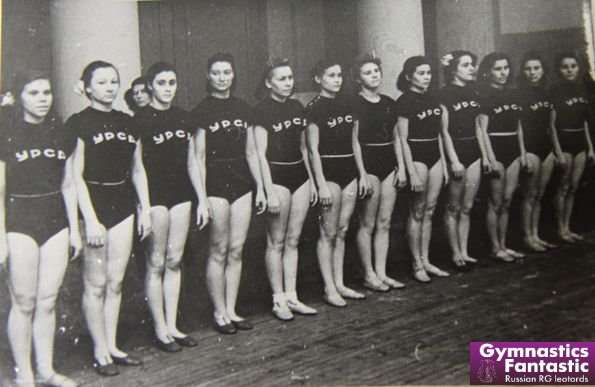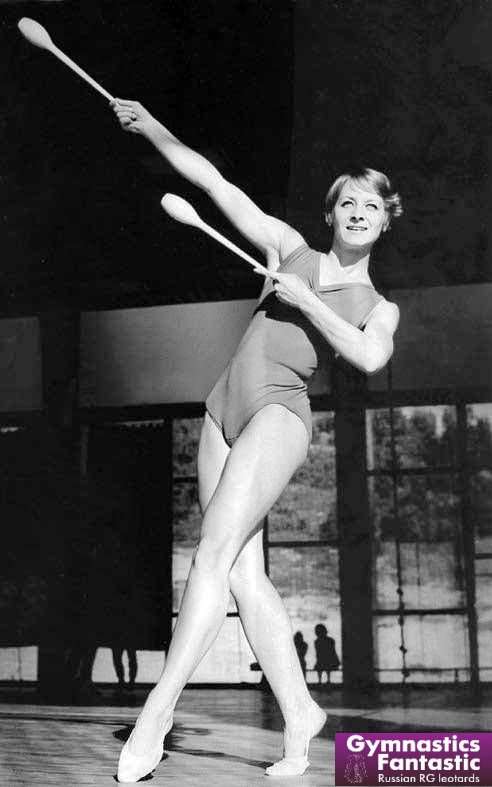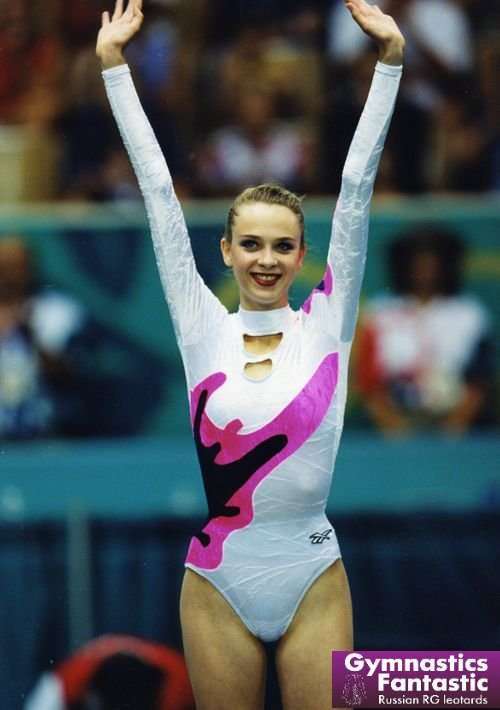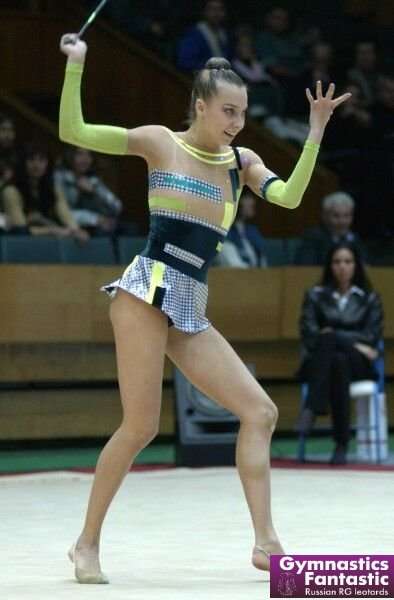Evolution of rhythmic gymnastics leotard
Today rhythmic gymnastics is not only super complicated jumps, turns, flexibility elements, but it’s also gorgeous play of colors on the leotards. In other words, now gymnasts perform not in “swimming suits”, but in leotards which look like mini-dress of figure-skaters. Such famous gymnasts as Irina Deriugina and Aleksandra Timoshenko could only dream of such outfit. Let’s have a closer look at the history of rhythmic gymnastics costume.
First rhythmic gymnasts wore ordinary gymnastics suits. They were also called “swimming suits”, though nobody swam in them, this term was widely used for the clothes of various gymnastics types. Sportswear industry wasn’t so well developed after the World War II, especially in USSR where rhythmic gymnastics was found. Leotards were made of cotton and they bleed after the first wash, moreover they didn’t stick tightly to the body. Well, post-WWII generation, which lived according to the principle “beggars can't be choosers”, didn’t pay attention to such trifles. And as for cheerfulness and high power energy is concerned, the gymnasts of those years could concede a penalty to contemporary glamorous gymnast even if she’s a “Miss Universe”.

Smile is the most important gymnast’s decoration. This is the first call-out to the Bulgarian National Team.

This is one of the first Ukrainian Soviet Socialist Republic Teams.

Triple absolute World Champion Maria Gigova had more than simple leotards as a result of Bulgarian consumer industry.
However, we should mention that those competition rules didn’t allow the gymnasts to flaunt in shiny leotards on the carpet. Originally they could perform only in self-colored suits. Later two-colored leotards were allowed, but big and bright patterns weren’t welcome (judges could lower the score for outfit violation).
In the middle of 1970s requirements to the leotards were rather strict. But the fabrics was different, it was more elastic and fitted tight, emphasizing body lines. White and a little bit transparent leotards were in fashion. That’s why rhythmic gymnastics performance was the most erotic programmes for USSR viewers. No wonder that they were popular not only among little girls and their moms, but among millions of USSR men languid from strict soviet morals.


In the beginning of 1980s there was an abrupt jump in exercises complexity; it was connected with the fact that new generation of young Bulgarian gymnasts appeared in the world arena. They were called “golden Bulgarian girls”. But this period didn’t bring any changes to the costumes except for new rhythmic gymnastics champions had more subtle figures in comparison with the RG stars of the past.

Simple forms but golden content.
In the late 1980s rhythmic gymnasts wore leotards in brighter colors.

Individuals all-around World Champion Galina Beloglazova stuck in memory in this leotard.
Apparatus were in leotards’ color. Not only ribbon, but ball, hoop, rope and even clubs match the leotards perfectly well.

When two Ukranian stars (Aleksandra Timoshenko and Oksana Skaldina) shone brightly in the sport sky, rhythmic gymnastics fashion was still very strict.

Olympic Champion 1992, Aleksandra Timoshenko – wonderful flower of rhythmic gymnastics.
Real revolution started in the next Olympic Games period. In order to popularize rhythmic gymnastics in other countries Islamic gymnasts were allowed to perform in unitards. However, such permission hardly made Islamic orthodoxies happy, as they believe that women in tight clothes commits even greater sin than women with bare arms, legs and other ‘forbidden” body parts. From the other hand, religious people whether they are Islamic, Christian or Jewish, don’t bring their daughters to rhythmic gymnastics. In spite of this, many gymnasts from different countries liked new fashionable idea. Anyway, performance in unitard was a usual thing in Atlanta Olympic Games.

Space story from Amina Zaripova from Russia
But traditional leotard wasn’t buried in the trunk. It became brighter with many applications and pattern which were not less freakish than on the abstractionists’ pictures.

Ekaterina Serebrianskaia got in the Olympic podium in this leotard (Atlanta 1996)

This photo was taken in 1995, when Ekaterina became absolute World Champion! Nice set, isn’t it?
Two different costume models broadened the opportunities for gymnasts to express themselves. Gymnasts with ample curves (as judged by gymnastics rates) preferred to wear traditional leotards. Tight unitards only showed extra kilos. But if a gymnast was high and long-legged, had great choreography skills, long suits emphasized the beauty of her lines and made her postures clearer. That’s why Tamara Erofeeva always performed in unitards before the skirts appeared.

Tamara Eropheeva, 1998. Simple, but stylish.
Perhaps, old and desperate rhythmic gymnastics lovers in the depth of their hearts are still missing the epoch between Barcelona 1992 and Sidney 2000 in spite of the today riot of color of the costumes covered by the great amount of crystals. It was the blossom of so called “old school gymnastics” based not on the work of the “double-jointed body”, but on the combination of classical choreography and irreproachable mastery of apparatus. Then high gymnasts (1m 70cm and higher) became the world leaders in rhythmic gymnastics. Long unitards made their figures even longer. Here’s some examples of costumes in style of “classical minimalism”:

The stuff but not the fluff. Elena Vitrichenko

Spain rhythmic gymnast Almudena Cid Tostado

Natalia Lipkovskaia. The position is quite freakish, but the lines are clear.
After the Olympiad 2000 there was such a fundamental change in Rhythmic Gymnastics Rules, so that the journalists called it “upside down turn”. Moreover, that was not only a metaphor, but even the viewers had an impression that gymnasts spent the best part of their routine in upside down position…
However the costume innovations were liked by everybody. Henceforth rhythmic gymnasts were allowed to perform in short skirts and dresses. Alina Kabaeva was the first who appeared in skirt at the official RG Event (Deriugina Cup 2001, Kiev, Ukraine). And almost all the gymnasts wore new and fashionable costumes by the end of the season – at the World Championship in Madrid.
But on the eve of the Championship gymnasts had to resew their skirts urgently, because not all of them read the rules carefully which included some restrictions. For example, asymmetric models and skirts made of flaps weren’t allowed. Later FIG committee allowed both asymmetry and some fringe, as they understood how the variety of costumes attracts the audience.
We’ll remind you that it was Russian coach Irina Viner who initiated skirts in rhythmic gymnastics (she was vice-president of FIG committee those years). Some people still think she did it because of the only reason – to hide extra kilos of Alina Kabaeva. Viner’s favourite student had a really different figure than the slim and spiny ones Batyrshina, Erofeeva, Bessonova. But what can be hidden by mini skirt?...

New costume only emphasized the appetizing shapes of Alina Kabaeva
Now let’s remember the performances of Bessonova and her costumes:

Ukrainian souvenir. In this leotard Anna stepped on the bronze step of Beijing 2008

This is the famous “Swanlake”. Here Anna is Odillia

Here she’s Odetta…
The music from the word famous ballet was always popular in rhythmic gymnastics. Compare some more leotards with swan motives.

Black swan of Olga Kapranova, 2008

And here’s the whole swan flight. Team Russia 2010

Another swan. But this swan belongs to Camille Saint-Sans. Julia Barsukova, Olympic Champion 2000. Skirts weren’t allowed yet.
Frankly speaking, gymnasts (or leotard designers) abuse the “birds theme”. Flocks and wings could be seen even there where they were not supposed to be according to the plot.

Olga Kapranova performed in this leotard to the music from “Don Quixote” ballet. But her costume reminds a swan
Most leotards for performance of the world famous gymnasts are rich in Swarovski crystals. Of course, it creates the beautiful play of color as the crystals shine and sparkle under the border lights. But at the same time there’s been some monotony in gymnastics fashion now.
It’s quite clear that the rhythmic gymnastics costumes can not be the same as in ice-skating. Big and long skirts or wide sleeves will only prevent them from free motion. More than that, the problem of image creation is not so important in rhythmic gymnastics. But the viewr’s eye always seeks for something that stands out. And sometimes a simple, but quite different leotard becomes catchier. For example, many people still remember this:

“small dress” of Natalia Godunko

Famous “Humble-bee flight”. Routine that made Natalia Godunko a Bronze Europe Champion 2005
We didn’t tell you about the technology of leotards’ creation. This is quite different topic (about design, fabrics and decoration). We’ll just mention that very catchy, beautiful and comfortable leotard of high quality you may order at this particular web-store.
In conclusion, we’ll tell you a trifle thing: the form will never stand for it’ content. And if a gymnast performs badly, neither Swarovski crystals nor real diamonds won’t help. One poet said: “The beauty is not the vessel full of emptiness, but fire sparkling in the vessel”…
01 Sep 2016 at 06:00
01 Sep 2016 at 06:00
01 Sep 2016 at 06:00
Like it? Tell your friends
















